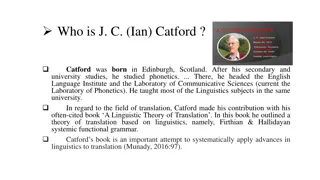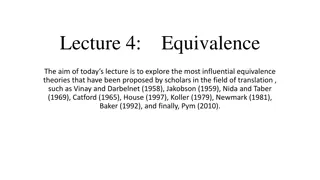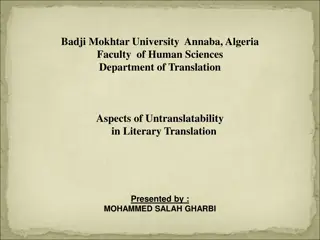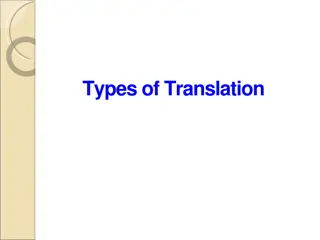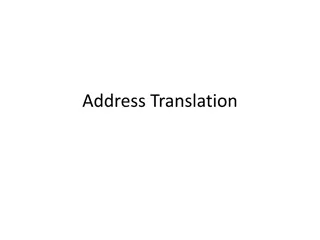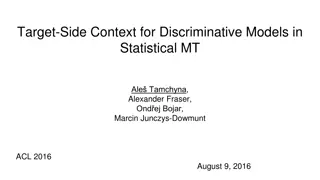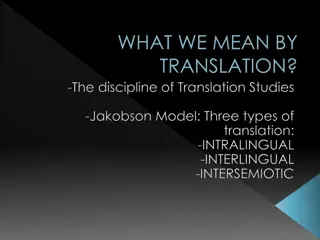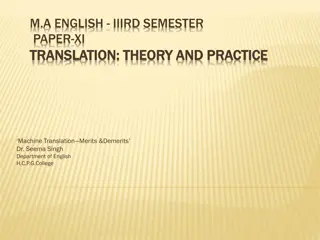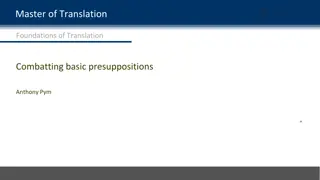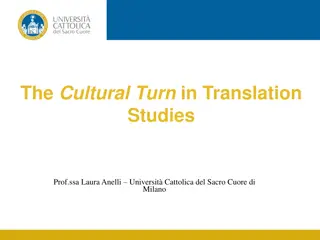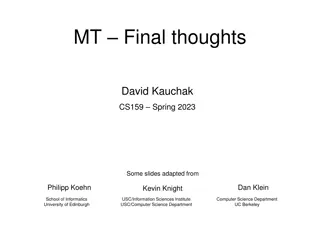Understanding Translation Shifts According to Catford (1965)
Definition and explanation of translation shifts according to Catford (1965), focusing on formal correspondence, levels of shifts, structure shifts, category shifts, class shifts, unit shifts, and intra-system shifts in the process of translating from the source language (SL) to the target language (TL).
Download Presentation

Please find below an Image/Link to download the presentation.
The content on the website is provided AS IS for your information and personal use only. It may not be sold, licensed, or shared on other websites without obtaining consent from the author. Download presentation by click this link. If you encounter any issues during the download, it is possible that the publisher has removed the file from their server.
E N D
Presentation Transcript
What is a Translation Shift? What is a Translation Shift? Catford (1965:73) defines translation shifts as departures from formal correspondence in the process of going from the SL to the TL . Let s re-examine Catford s definition of formal correspondent : Formal correspondent is any TL category (unit, class, element of structure, etc.) which can be said to occupy, as nearly as possible, the same place in the economy of the TL as the given SL category occupies in the SL (Catford 1965: 27). In the above definition, Catford focuses on the form and the place it occupies in the TL; all the above mentioned items are forms (unit, class, element of structure, the word category, etc.) all indicate form rather than content. Even the expression it occupies , on its value, refers to a place within some arrangement (like the case of word order) of some items, formally speaking. The point stressed in Catford s definition of shift is that it is a change because it indicates some departure from the SLT author s formal selections (unit, class, element of structure, etc.) or the places they occupy; in other words, changing their forms or places in the TLT. Catford offered a number of types of shifts (see slides below).
Level shift: is defined as a SL item at one linguistic level has a TL translation equivalent at a different level; as the example below: Types of Types of Shifts: Shifts: E.g. You are welcome. into . The level of grammar in the ST (a whole sentence) is shifted into a lexical level in Arabic, one collocational expression . The traffic word stop (lexical level) is translated into a semiotic level of a sign of red color. E.g. He has encountered a problem this morning. Translation Shifts The grammatical level of SLT (present perfect = has +pp) is shifted, in part, lexically by the insertion of the Arabic particle . Category shift: This is divided into divided into four types: 1. Structure shifts 2. Class shifts 3. Unit shifts 4. Intra-system shifts Jump to the next slide. Level Category Shifts Shifts
Structure shifts: which involve a grammatical change between the structure of the ST and that of the TT. E.g. . Inspiration could be sparked by the shortest of moments to put the lifecycle of innovation into sustainable motion. Category Shifts You may see that there a number of structure shifts, most obvious of which is the shift from active voice structure into passive voice one. Category Shifts Class shifts: which occur when a SL item is translated into a TL item which belongs to a different grammatical class. E.g. We should do the assignment. As you can observe there is a class shift from an auxiliary verb (should) in the SLT to an Arabic preposition ( ) in the TLT. Structure Shifts Class Shifts Unit shifts: , which involve changes in rank, such as translating a phrase/expression/clause in one language into a word in another, as in translating the English sentence You are defeated. into one word . Or the Muslim greeting being ideologically translated into the English Hello . Intra-system shifts: this occur where SL and TL possess systems which approximately correspond formally as to their constitution, but when translation involves selection of a non-corresponding term in the TL system. For example the gender system in English marks three categories: masculine, feminine, and neutral, whereas Arabic offers two: masculine and feminine. For example : It is a cat. (neutral), will be translated by an Arabic intra-system shift into: (feminine) Unit Shifts Intra-system Shifts
GOOD LUCK GOOD LUCK


